Guinea-Bissau
| Republic of Guinea-Bissau |
||||||
|---|---|---|---|---|---|---|
|
||||||
| Motto: "Unidade, Luta, Progresso" (Portuguese) "Unity, Fight, Progress" |
||||||
| Anthem: Esta é a Nossa Pátria Bem Amada (Portuguese) This is Our Beloved Homeland |
||||||
 Location of Guinea-Bissau (dark blue) – in Africa (light blue & dark grey) |
||||||
| Capital and largest city | Bissau 11°52′N 15°36′W / 11.867°N 15.600°W | |||||
| Official languages | Portuguese | |||||
| Recognised national languages | Upper Guinea Creole | |||||
| Ethnic groups | ||||||
| Demonym | Bissau-Guinean[1] | |||||
| Government | Unitary semi-presidential republic | |||||
| • | President | José Mário Vaz | ||||
| • | Prime Minister | Umaro Sissoco Embaló | ||||
| Legislature | National People's Assembly | |||||
| Independence from Portugal | ||||||
| • | Declared | 24 September 1973 | ||||
| • | Recognized | 10 September 1974 | ||||
| Area | ||||||
| • | Total | 36,125 km2 (136th) 13,948 sq mi |
||||
| • | Water (%) | 22.4 | ||||
| Population | ||||||
| • | 2014 estimate | 1,693,398[2] (148th) | ||||
| • | Density | 46.9/km2 (154th) 121.4/sq mi |
||||
| GDP (PPP) | 2016 estimate | |||||
| • | Total | $2.838 billion[3] | ||||
| • | Per capita | $1,561[3] | ||||
| GDP (nominal) | 2016 estimate | |||||
| • | Total | $1.116 billion[3] | ||||
| • | Per capita | $613[3] | ||||
| Gini (2002) | 35 medium |
|||||
| HDI (2013) | low · 177th |
|||||
| Currency | West African CFA franc (XOF) | |||||
| Time zone | GMT (UTC+0) | |||||
| Drives on the | right | |||||
| Calling code | +245 | |||||
| ISO 3166 code | GW | |||||
| Internet TLD | .gw | |||||
Guinea-Bissau (![]() i/ˈɡɪni bɪˈsaʊ/, GI-nee-bi-SOW), officially the Republic of Guinea-Bissau (Portuguese: República da Guiné-Bissau, pronounced: [ʁeˈpublikɐ dɐ ɡiˈnɛ biˈsaw]), is a country in West Africa. It covers 36,125 square kilometres (13,948 sq mi) with an estimated population of 1,704,000.
i/ˈɡɪni bɪˈsaʊ/, GI-nee-bi-SOW), officially the Republic of Guinea-Bissau (Portuguese: República da Guiné-Bissau, pronounced: [ʁeˈpublikɐ dɐ ɡiˈnɛ biˈsaw]), is a country in West Africa. It covers 36,125 square kilometres (13,948 sq mi) with an estimated population of 1,704,000.
Guinea-Bissau was once part of the kingdom of Gabu, as well as part of the Mali Empire. Parts of this kingdom persisted until the 18th century, while a few others were under some rule by the Portuguese Empire since the 16th century. In the 19th century, it was colonized as Portuguese Guinea. Upon independence, declared in 1973 and recognised in 1974, the name of its capital, Bissau, was added to the country's name to prevent confusion with Guinea (formerly French Guinea). Guinea-Bissau has a history of political instability since independence, and no elected president has successfully served a full five-year term.
Only 14% of the population speaks Portuguese, established as the official language in the colonial period. Almost half the population (44%) speaks Crioulo, a Portuguese-based creole language, and the remainder speak a variety of native African languages. The main religions are African traditional religions and Islam; there is a Christian (mostly Roman Catholic) minority. The country's per-capita gross domestic product is one of the lowest in the world.
Guinea-Bissau is a member of the United Nations, African Union, Economic Community of West African States, Organisation of Islamic Cooperation, the Latin Union, Community of Portuguese Language Countries, La Francophonie and the South Atlantic Peace and Cooperation Zone.
History
Guinea-Bissau was once part of the kingdom of Gabu, part of the Mali Empire; parts of this kingdom persisted until the 18th century. Other parts of the territory in the current country were considered by the Portuguese as part of their empire.[5] Portuguese Guinea was known as the Slave Coast, as it was a major area for the exportation of African slaves by Europeans to the western hemisphere.
Early reports of Europeans reaching this area include those of the Venetian Alvise Cadamosto's voyage of 1455,[6] the 1479–1480 voyage by Flemish-French trader Eustache de la Fosse,[7] and Diogo Cão. In the 1480s this Portuguese explorer reached the Congo River and the lands of Bakongo, setting up the foundations of modern Angola, some 4200 km down the African coast from Guinea-Bissau.[8]
Although the rivers and coast of this area were among the first places colonized by the Portuguese, who set up trading posts in the 16th century, they did not explore the interior until the 19th century. The local African rulers in Guinea, some of whom prospered greatly from the slave trade, controlled the inland trade and did not allow the Europeans into the interior. They kept them in the fortified coastal settlements where the trading took place.[9] African communities that fought back against slave traders also distrusted European adventurers and would-be settlers. The Portuguese in Guinea were largely restricted to the port of Bissau and Cacheu. A small number of European settlers established isolated farms along Bissau's inland rivers.[9]
For a brief period in the 1790s, the British tried to establish a rival foothold on an offshore island, at Bolama.[10] But by the 19th century the Portuguese were sufficiently secure in Bissau to regard the neighbouring coastline as their own special territory, also up north in part of present South Senegal.
An armed rebellion beginning in 1956 by the African Party for the Independence of Guinea and Cape Verde (PAIGC) under the leadership of Amílcar Cabral gradually consolidated its hold on then Portuguese Guinea.[11] Unlike guerrilla movements in other Portuguese colonies, the PAIGC rapidly extended its military control over large portions of the territory, aided by the jungle-like terrain, its easily reached borderlines with neighbouring allies, and large quantities of arms from Cuba, China, the Soviet Union, and left-leaning African countries.[12] Cuba also agreed to supply artillery experts, doctors, and technicians.[13] The PAIGC even managed to acquire a significant anti-aircraft capability in order to defend itself against aerial attack. By 1973, the PAIGC was in control of many parts of Guinea, although the movement suffered a setback in January 1973 when Cabral was assassinated.[14]
Independence (1973)

Independence was unilaterally declared on 24 September 1973. Recognition became universal following the 25 April 1974 socialist-inspired military coup in Portugal, which overthrew Lisbon's Estado Novo regime.[15]
Luís Cabral, brother of Amílcar and co-founder of PAIGC, was appointed the first President of Guinea-Bissau. Following independence, the PAIGC killed thousands of local Guinean soldiers who had fought along with the Portuguese Army against guerrillas. Some escaped to settle in Portugal or other African nations.[16] One of the massacres occurred in the town of Bissorã. In 1980 the PAIGC acknowledged in its newspaper Nó Pintcha (dated 29 November 1980) that many Gueinean soldiers had been executed and buried in unmarked collective graves in the woods of Cumerá, Portogole, and Mansabá.
The country was controlled by a revolutionary council until 1984. The first multi-party elections were held in 1994. An army uprising in May 1998 led to the Guinea-Bissau Civil War and the president's ousting in June 1999.[17] Elections were held again in 2000, and Kumba Ialá was elected president.[18]
In September 2003, a military coup was conducted. The military arrested Ialá on the charge of being "unable to solve the problems".[19] After being delayed several times, legislative elections were held in March 2004. A mutiny of military factions in October 2004 resulted in the death of the head of the armed forces and caused widespread unrest.
Vieira years
In June 2005, presidential elections were held for the first time since the coup that deposed Ialá. Ialá returned as the candidate for the PRS, claiming to be the legitimate president of the country, but the election was won by former president João Bernardo Vieira, deposed in the 1999 coup. Vieira beat Malam Bacai Sanhá in a runoff election. Sanhá initially refused to concede, claiming that tampering and electoral fraud occurred in two constituencies including the capital, Bissau.[20]
Despite reports of arms entering the country prior to the election and some "disturbances during campaigning," including attacks on government offices by unidentified gunmen, foreign election monitors described the 2005 election overall as "calm and organized".[21]
Three years later, PAIGC won a strong parliamentary majority, with 67 of 100 seats, in the parliamentary election held in November 2008.[22] In November 2008, President Vieira's official residence was attacked by members of the armed forces, killing a guard but leaving the president unharmed.[23]
On 2 March 2009, however, Vieira was assassinated by what preliminary reports indicated to be a group of soldiers avenging the death of the head of joint chiefs of staff, General Batista Tagme Na Wai, who had been killed in an explosion the day before.[24] Vieira's death did not trigger widespread violence, but there were signs of turmoil in the country, according to the advocacy group Swisspeace.[25] Military leaders in the country pledged to respect the constitutional order of succession. National Assembly Speaker Raimundo Pereira was appointed as an interim president until a nationwide election on 28 June 2009.[26] It was won by Malam Bacai Sanhá of the PAIGC, against Kumba Ialá as the presidential candidate of the PRS.
On 9 January 2012, President Sanhá died of complications from diabetes, and Pereira was again appointed as an interim president. On the evening of 12 April 2012, members of the country's military staged a coup d'état and arrested the interim president and a leading presidential candidate.[27] Former vice chief of staff, General Mamadu Ture Kuruma, assumed control of the country in the transitional period and started negotiations with opposition parties.[28][29]
Politics
Guinea-Bissau is a republic. In the past, the government had been highly centralized. Multi-party governance was not established until mid-1991. The president is the head of state and the prime minister is the head of government. Since 1974, no president has successfully served a full five-year term.[30]
At the legislative level, a unicameral Assembleia Nacional Popular (National People's Assembly) is made up of 100 members. They are popularly elected from multi-member constituencies to serve a four-year term. The judicial system is headed by a Tribunal Supremo da Justiça (Supreme Court), made up of nine justices appointed by the president; they serve at the pleasure of the president.[31]
The two main political parties are the PAIGC (African Party for the Independence of Guinea and Cape Verde) and the PRS (Party for Social Renewal). There are more than 20 minor parties.[32]
Foreign relations
Guinea-Bissau follows a nonaligned foreign policy and seeks friendly and cooperative relations with a wide variety of states and organizations.
Military
A 2008 estimate put the size of the Guinea-Bissau Armed Forces at around 4,000 personnel.[33]
Administrative divisions
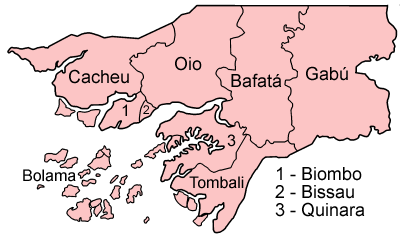

Guinea-Bissau is divided into eight regions (regiões) and one autonomous sector (sector autónomo). These, in turn, are subdivided into 37 Sectors. The regions are:
| a Autonomous sector. |
Geography
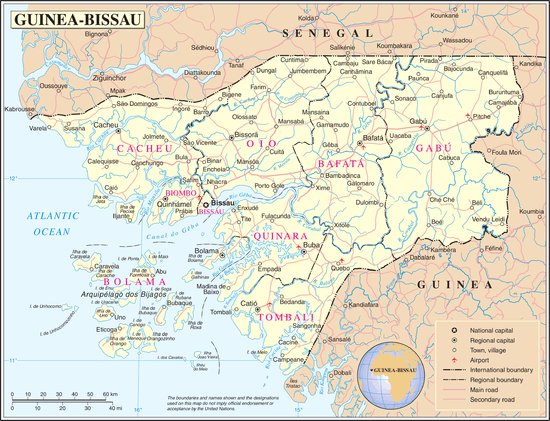
_(2).jpg)
_(2).jpg)
Guinea-Bissau is bordered by Senegal to the north and Guinea to the south and east, with the Atlantic Ocean to its west. It lies mostly between latitudes 11° and 13°N (a small area is south of 11°), and longitudes 13° and 17°W.
At 36,125 square kilometres (13,948 sq mi), the country is larger in size than Taiwan or Belgium. It lies at a low altitude; its highest point is 300 metres (984 ft). The terrain of is mostly low coastal plain with swamps of Guinean mangroves rising to Guinean forest-savanna mosaic in the east.[34] Its monsoon-like rainy season alternates with periods of hot, dry harmattan winds blowing from the Sahara. The Bijagos Archipelago lies off of the mainland.[35]
Climate
Guinea-Bissau is warm all year around and there is little temperature fluctuation; it averages 26.3 °C (79.3 °F). The average rainfall for Bissau is 2,024 millimetres (79.7 in) although this is almost entirely accounted for during the rainy season which falls between June and September/October. From December through April, the country experiences drought.[36]
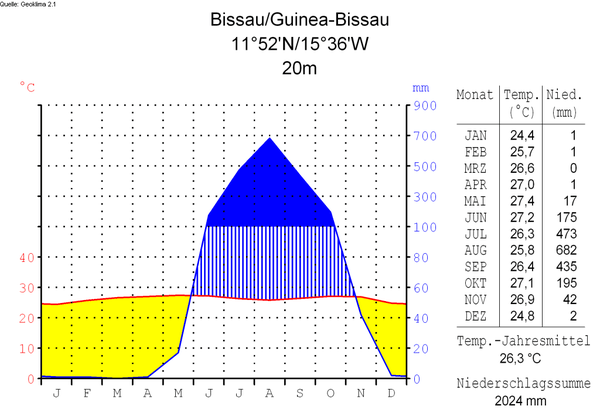
Environmental issues
Severe environmental issues include deforestation; soil erosion; overgrazing and overfishing.[34]
Economy
_(2).jpg)
Guinea-Bissau's GDP per capita is one of the lowest in the world, and its Human Development Index is one of the lowest on earth. More than two-thirds of the population lives below the poverty line.[37] The economy depends mainly on agriculture; fish, cashew nuts and ground nuts are its major exports.
A long period of political instability has resulted in depressed economic activity, deteriorating social conditions, and increased macroeconomic imbalances. It takes longer on average to register a new business in Guinea-Bissau (233 days or about 33 weeks) than in any other country in the world except Suriname.[38]
Guinea-Bissau has started to show some economic advances after a pact of stability was signed by the main political parties of the country, leading to an IMF-backed structural reform program.[39] The key challenges for the country in the period ahead are to achieve fiscal discipline, rebuild public administration, improve the economic climate for private investment, and promote economic diversification. After the country became independent from Portugal in 1974 due to the Portuguese Colonial War and the Carnation Revolution, the rapid exodus of the Portuguese civilian, military, and political authorities resulted in considerable damage to the country's economic infrastructure, social order, and standard of living.
After several years of economic downturn and political instability, in 1997, Guinea-Bissau entered the CFA franc monetary system, bringing about some internal monetary stability.[40] The civil war that took place in 1998 and 1999, and a military coup in September 2003 again disrupted economic activity, leaving a substantial part of the economic and social infrastructure in ruins and intensifying the already widespread poverty. Following the parliamentary elections in March 2004 and presidential elections in July 2005, the country is trying to recover from the long period of instability, despite a still-fragile political situation.
Beginning around 2005, drug traffickers based in Latin America began to use Guinea-Bissau, along with several neighboring West African nations, as a transshipment point to Europe for cocaine.[41] The nation was described by a United Nations official as being at risk for becoming a "narco-state".[42] The government and the military have done little to stop drug trafficking, which increased after the 2012 coup d'état.[43]
Guinea-Bissau is a member of the Organization for the Harmonization of Business Law in Africa (OHADA).[44]
Society
Demographics
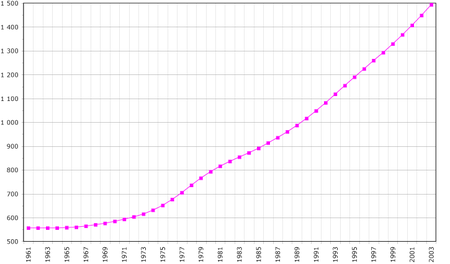
According to the 2010 revision of the UN World Population Prospects, Guinea-Bissau's population was 1,515,000 in 2010, compared to 518,000 in 1950.[45] The proportion of the population below the age of 15 in 2010 was 41.3%, 55.4% were aged between 15 and 65 years of age, while 3.3% were aged 65 years or older.[45]
Ethnic groups
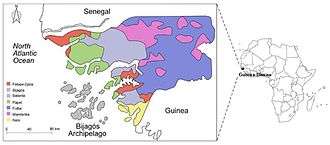
The population of Guinea-Bissau is ethnically diverse and has many distinct languages, customs, and social structures.
Bissau-Guineans can be divided into the following ethnic groups:
- Fula and the Mandinka-speaking people, who comprise the largest portion of the population and are concentrated in the north and northeast;
- Balanta and Papel people, who live in the southern coastal regions; and
- Manjaco and Mancanha, who occupy the central and northern coastal areas.
Most of the remainder are mestiços of mixed Portuguese and African descent, including a Cape Verdean minority.[46]
Portuguese natives comprise a very small percentage of Bissau-Guineans. After Guinea-Bissau gained independence, most of the Portuguese nationals left the country. The country has a tiny Chinese population.[47] These include traders and merchants of mixed Portuguese and Chinese ancestry from Macau, a former Asian Portuguese colony.
Major cities
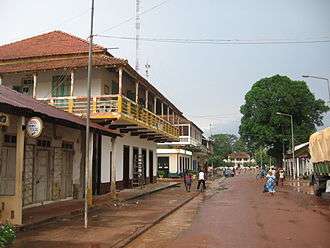
Main cities in Guinea-Bissau include:
| Rank | City | Population | Region | |
|---|---|---|---|---|
| 1979 Census | 2005 estimate | |||
| 1 | Bissau | 109,214 | 388,028 | Bissau |
| 2 | Bafatá | 13,429 | 22,521 | Bafatá |
| 3 | Gabú | 7,803 | 14,430 | Gabú |
| 4 | Bissorã | N/A | 12,688 | Oio |
| 5 | Bolama | 9,100 | 10,769 | Bolama |
| 6 | Cacheu | 7,600 | 10,490 | Cacheu |
| 7 | Bubaque | 8,400 | 9,941 | Bolama |
| 8 | Catió | 5,170 | 9,898 | Tombali |
| 9 | Mansôa | 5,390 | 7,821 | Oio |
| 10 | Buba | N/A | 7,779 | Quinara |
| 11 | Quebo | N/A | 7,072 | Quinara |
| 12 | Canchungo | 4,965 | 6,853 | Cacheu |
| 13 | Farim | 4,468 | 6,792 | Oio |
| 14 | Quinhámel | N/A | 3,128 | Biombo |
| 15 | Fulacunda | N/A | 1,327 | Quinara |
Languages
14% of the population speaks the official language Portuguese, the language of government and national communication during centuries of colonial rule. 44% speak Kriol, a Portuguese-based creole language, which is effectively a national language of communication among groups. The remainder speak a variety of native African languages unique to ethnicities.[48]
Most Portuguese and Mestiços speakers also have one of the African languages and Kriol as additional languages. French is also taught in schools because Guinea-Bissau is surrounded by French-speaking nations. Guinea-Bissau is a full member of the Francophonie.[49]
Religion

Throughout the 20th century, most Bissau-Guineans practiced some form of Animism. In the early 21st century, many have adopted Islam, which is now practiced by 50% of the country's population. Most of Guinea-Bissau's Muslims are of the Sunni denomination with approximately 2% belonging to the Ahmadiyya sect.[52]
Approximately 10% of the country's population belong to the Christian community, and 40% continue to hold Indigenous beliefs. These statistics can be misleading, however, as many residents practice syncretic forms of Islamic and Christian faiths, combining their practices with traditional African beliefs.[53][54]
Roman Catholic Church claims most of Christian community.
Health
The WHO estimates there are fewer than 5 physicians per 100,000 persons in the country,[55] down from 12 per 100,000 in 2007.[56]
The prevalence of HIV-infection among the adult population is 1.8%.[57] Only 20% of infected pregnant women receive anti retroviral coverage to prevent transmission to newborns.[58]
Malaria kills more residents; 9% of the population have reported infection,[59] It causes three times as many deaths as AIDS.[60] In 2008, fewer than half of children younger than five slept under antimalaria nets or had access to antimalarial drugs.[61]
The WHO's estimate of life expectancy for a child born in 2008 was 49 years and 47 years for a boy.[62]
Despite lowering rates in surrounding countries, cholera rates were reported in November 2012 to be on the rise, with 1,500 cases reported and nine deaths. A 2008 cholera epidemic in Guinea-Bissau affected 14,222 people and killed 225.[63]
The 2010 maternal mortality rate per 100,000 births for Guinea Bissau was 1000. This compares with 804.3 in 2008 and 966 in 1990. The under 5 mortality rate, per 1,000 births, was 195 and the neonatal mortality as a percentage of under 5's mortality was 24. The number of midwives per 1,000 live births was 3; one out of eighteen pregnant women die as a result of pregnancy.[64] According to a 2013 UNICEF report, 50% of women in Guinea Bissau had undergone female genital mutilation.[65] In 2010, Guinea Bissau had the 7th highest maternal mortality rate in the world.[66]
Education
Education is compulsory from the age of 7 to 13.[67] The enrollment of boys is higher than that of girls.[67] In 1998, the gross primary enrollment rate was 53.5%, with higher enrollment ratio for males (67.7%) compared to females (40%).[68]
Child labor is very common.[67] In 2011 the literacy rate was estimated at 55.3% (68.9% male, and 42.1% female).[69]
Guinea-Bissau has several secondary schools (general as well as technical) and a number of universities, to which an institutionally autonomous Faculty of Law as well as a Faculty of Medicine[70] have been added.
Culture

Music
The music of Guinea-Bissau is usually associated with the polyrhythmic gumbe genre, the country's primary musical export. However, civil unrest and other factors have combined over the years to keep gumbe, and other genres, out of mainstream audiences, even in generally syncretist African countries.[71]
The calabash is the primary musical instrument of Guinea-Bissau,[72] and is used in extremely swift and rhythmically complex dance music. Lyrics are almost always in Guinea-Bissau Creole, a Portuguese-based creole language, and are often humorous and topical, revolving around current events and controversies.[73]
The word gumbe is sometimes used generically, to refer to any music of the country, although it most specifically refers to a unique style that fuses about ten of the country's folk music traditions.[74] Tina and tinga are other popular genres, while extent folk traditions include ceremonial music used in funerals, initiations and other rituals, as well as Balanta brosca and kussundé, Mandinga djambadon, and the kundere sound of the Bissagos Islands.[75]
Cuisine
Rice is a staple in the diet of residents near the coast and millet a staple in the interior. Fruits and vegetables are commonly eaten along with cereal grains. The Portuguese encouraged peanut production. Vigna subterranea (Bambara groundnut) and Macrotyloma geocarpum (Hausa groundnut) are also grown. Black-eyed peas are also part of the diet. Palm oil is harvested.
Common dishes include soups and stews. Common ingredients include yams, sweet potato, cassava, onion, tomato and plantain. Spices, peppers and chilis are used in cooking, including Aframomum melegueta seeds (Guinea pepper).
Film
Flora Gomes is an internationally renowned film director; his most famous film is Nha Fala (English: My Voice).[76] Gomes's Mortu Nega (Death Denied) (1988)[77] was the first fiction film and the second feature film ever made in Guinea-Bissau. (The first feature film was N’tturudu, by director Umban u’Kest in 1987.) At FESPACO 1989, Mortu Nega won the prestigious Oumarou Ganda Prize. Mortu Nega is in Creole with English subtitles. In 1992, Gomes directed Udju Azul di Yonta,[78] which was screened in the Un Certain Regard section at the 1992 Cannes Film Festival.[79] Gomes has also served on the boards of many Africa-centric film festivals.[80]
See also
- Outline of Guinea-Bissau
- Index of Guinea-Bissau-related articles
- Transport in Guinea-Bissau
- 2010 Guinea-Bissau military unrest
References
![]() This article incorporates public domain material from the CIA World Factbook website https://www.cia.gov/library/publications/the-world-factbook/index.html.
This article incorporates public domain material from the CIA World Factbook website https://www.cia.gov/library/publications/the-world-factbook/index.html.
- ↑ "Guinea-Bissau" – Field Listing: Nationality. The World Factbook 2013-14. Washington, DC: Central Intelligence Agency, 2013. Retrieved 15 July 2015.
- ↑ "The World Factbook -- Field Listing - Population - CIA". Central Intelligence Agency. Retrieved 2015-03-07.
- 1 2 3 4 "Guinea-Bissau". International Monetary Fund. Retrieved 17 April 2013.
- ↑ "2014 Human Development Report Summary" (PDF). United Nations Development Programme. 2014. pp. 21–25. Retrieved 27 July 2014.
- ↑ Empire of Kaabu, West Africa. Accessgambia.com. Retrieved 22 June 2013.
- ↑ Alvise Cadamosto. Nndb.com. Retrieved 22 June 2013.
- ↑ Eustache De La Fosse (1992). Voyage d'Eustache Delafosse sur la côte de Guinée, au Portugal et en Espagne: 1479–1481. Editions Chandeigne. ISBN 978-2-906462-03-8. Retrieved 19 December 2012.
- ↑ Diogo Cão at the Wayback Machine (archived 8 February 2007). win.tue.nl
- 1 2 "A Brief History of Guinea-Bissau – Part 1". Africanhistory, US Department of State, at About.com. Retrieved 22 June 2013.
- ↑ British Library – Endangered Archive Programme (EAP). Inep-bissau.org (18 March 1921). Retrieved 22 June 2013.
- ↑ Amilcar Cabral 1966 "The Weapon of Theory". Address delivered to the first Tricontinental Conference of the Peoples of Asia, Africa and Latin America held in Havana in January 1966. Marxists.org. Retrieved 22 June 2013.
- ↑ The PAIC Programme Appendix. Marxists.org. Retrieved 22 June 2013.
- ↑ El Tahri, Jihan (2007). Cuba! Africa! Revolution!. BBC Television. Event occurs at 50:00–60:00. Retrieved 2 May 2007.
- ↑ Brittain, Victoria (17 January 2011). "Africa: a continent drenched in the blood of revolutionary heroes". The Guardian. London.
- ↑ Embassy of The Republic of Guinea-Bissau – Country Profile. Diplomaticandconsular.com (12 April 2012). Retrieved 22 June 2013.
- ↑ Guiné-Bissau: Morreu Luís Cabral, primeiro presidente do país. Expresso.sapo.pt (30 May 2009). Retrieved 22 June 2013.
- ↑ Uppsala Conflict Data Program Conflict Encyclopedia, Guinea Bissau: government, in depth, Negotiations, Veira's surrender and the end of the conflict, viewed 12 July 2013,
- ↑ Guinea-Bissau's Kumba Yala: from crisis to crisis. Afrol.com. Retrieved 22 June 2013.
- ↑ Smith, Brian (27 September 2003) "US and UN give tacit backing to Guinea Bissau coup", Wsws.org, September 2003. Retrieved 22 June 2013
- ↑ GUINEA-BISSAU: Vieira officially declared president. irinnews.org (10 August 2005).
- ↑ "Army man wins G Bissau election". London: BBC News. 28 July 2005. Retrieved 5 January 2010.
- ↑ Guinea Bissau vote goes smooth amid hopes for stability. AFP via Google.com (16 November 2008). Retrieved 22 June 2013.
- ↑ Balde, Assimo (24 November 2008). "Coup attempt fails in Guinea-Bissau". London: The Independent UK independent.co.uk. Retrieved 28 June 2010.
- ↑ Soldiers kill fleeing President at the Wayback Machine (archived 8 March 2009). news.com.au (2 March 2009).
- ↑ Elections, Guinea-Bissau (27 May 2009). "On the Radio Waves in Guinea-Bissau". swisspeace. Archived from the original on 8 December 2009. Retrieved 7 February 2010.
- ↑ "Já foi escolhida a data para a realização das eleições presidenciais entecipadas". Bissaudigital.com. 1 April 2009. Retrieved 26 June 2010.
- ↑ "Tiny Guinea-Bissau becomes latest West African nation hit by coup". Bissau. 12 April 2012. Retrieved 14 April 2012.
- ↑ Embalo, Allen Yero (14 April 2012). "Fears grow for members of toppled G.Bissau government". Agence France-Presse. Retrieved 2 May 2012.
- ↑ "Guinea-Bissau opposition vows to reach deal with junta | Radio Netherlands Worldwide". Rnw.nl. 15 April 2012. Retrieved 2 May 2012.
- ↑ CIA Factbook: Guinea-Bissau "Introduction"
- ↑ Guinea-Bissau Supreme Court. Stj.pt. Retrieved 22 June 2013.
- ↑ Guinea-Bissau Political Parties. Nationsencyclopedia.com. Retrieved 22 June 2013.
- ↑ http://www.un.org/peace/peacebuilding/Country-Specific%20Configurations/Guinea-Bissau/Background%20Paper%20on%20SSR%2018.06.2008.pdf
- 1 2
- ↑ Nossiter, Adam (4 November 2009) "Bijagós, a Tranquil Haven in a Troubled Land", The New York Times, 8 November 2009
- ↑ Guinea-Bissau Climate. Nationsencyclopedia.com. Retrieved 22 June 2013.
- ↑ World Bank profile. World Bank.org (31 May 2013). Retrieved 22 June 2013.
- ↑ The Economist. Pocket World in Figures (2008 ed.). London: Profile Books. ISBN 978-1861978448.
- ↑ Guinea-Bissau and the IMF. Imf.org (13 May 2013). Retrieved 22 June 2013.
- ↑ CFA Franc and Guinea-Bissau. Uemoa.int. Retrieved 22 June 2013.
- ↑ Guinea-Bissau:A narco-state?. Time. (29 October 2009). Retrieved 22 June 2013.
- ↑ Sullivan, Kevin (25 May 2008). "Route of Evil: How a tiny West African nation became a key smuggling hub for Colombian cocaine, and the price it is paying". The Washington Post.
- ↑ "Guinea-Bissau drug trade 'rises since coup'". London: BBC News. 31 July 2012. Retrieved 5 October 2012.
- ↑ "OHADA.com: The business law portal in Africa". Retrieved 22 March 2009.
- 1 2 3 Population Division of the Department of Economic and Social Affairs of the United Nations Secretariat, World Population Prospects: The 2010 Revision
- ↑ Guinea-Bissau ethnic classifications, Joshuaproject.net. Retrieved 22 June 2013.
- ↑ China-Guinea-Bissau. China.org.cn. Retrieved 22 June 2013.
- ↑ Crioulo, Upper Guinea. Ethnologue.org. Retrieved 22 June 2013.
- ↑ WELCOME TO THE INTERNATIONAL ORGANISATION OF LA FRANCOPHONIE'S OFFICIAL WEBSITE. Francophonie.org. Retrieved 22 June 2013.
- ↑ http://www.globalreligiousfutures.org/countries/guinea-bissau#/?affiliations_religion_id=0&affiliations_year=2010®ion_name=All%20Countries&restrictions_year=2013
- ↑ http://www.pewforum.org/2015/04/02/religious-projection-table/2010/percent/all/
- ↑ "The World's Muslims: Unity and Diversity" (PDF). Pew Forum on Religious & Public life. 9 August 2012. Retrieved 2 June 2014.
- ↑ "Guinea-Bissau", CIA the World Factbook, Cia.gov. Retrieved 5 February 2012.
- ↑ "Guinea-Bissau", Encyclopædia Britannica
- ↑ The WHO identified only 78 physicians in the entire Guinea-Bissau health workforce in 2009 data. ("Health workforce, infrastructure, essential medicines" (PDF). 2010. p. 118.) And the World Bank estimates that Guinea-Bissau had 1,575,446 residents in 2008. At the current rate of growth, 2009 population was expected to reach about 1.61 million people. Only 0.0048% are known to be medical doctors involved in patient care. The WHO estimate an average of about 20 per 100,000 across Africa, but reports a density per 10,000 population of <0.5 in its Physicians data covering the period to 2009. Guinea-Bissau has an unusually high ratio of nursing staff to doctors: including nurses and midwives; there are 64 medical professionals per 100,000 Bissau-Guineans
- ↑ The WHO estimates that there were 188 physicians working in the entire country as of 2007 ("Health workforce, infrastructure, essential medicines" (PDF). 2009. p. 98.). And The World Bank estimates that Guinea-Bissau had 1,541,040 residents in 2007 ("Midyear estimates of the resident population". 2010.). So, about 0.0122% of the permanent population were known to be medical doctors involved in patient care, as of 2007.
- ↑ The WHO estimates a 1.8% HIV-infection rate from 2007 data among 15- to 49-year-old Bissau-Guineans – see statistics on page 65 of: "2. Cause-specific mortality and morbidity" (PDF). WHO. 2010.. (The section's introduction describes estimation methodology).
- ↑ As of 2008, only 20% of HIV-infected mothers or sufferers with advanced cases had anti-retroviral drug access, see: "Health service coverage" (PDF). WHO. 2010. p. 91.. Coverage in the general population is lower.
- ↑ "Selected infectious diseases" (PDF). WHO. 2010. p. 76. Retrieved 9 June 2010. – 148,542 reported cases in 2008.
- ↑ According to the 2010 WHO report, the latest Malaria mortality rate per 100,000 Bissau-Guineans (180) is substantially greater than that for AIDS (65). ("Cause-specific mortality and morbidity" (PDF). WHO. 2010. p. 64. Retrieved 9 June 2010.) Among children younger than 5, malaria is nine times more deadly (p. 65).
- ↑ "Global Health Indicators: 4. Health service coverage" (PDF). WHO. 2010. p. 91.
- ↑ "Global Health Indicators: Mortality and burden of disease" (PDF). 2010. p. 50.. Healthy life expectancy at birth was 42. The probability of dying between a live-birth and age 5 was 19.5% (down from 24% in 1990, p.51).
- ↑ "Guinea Bissau: Cholera On the Rise". allafrica.com. 2012. Retrieved 15 November 2012.
- ↑ "The State Of The World's Midwifery". United Nations Population Fund. Retrieved August 2011. Check date values in:
|access-date=(help) - ↑ UNICEF 2013, p. 27.
- ↑ "Country Comparison :: Maternal mortality rate". The World Factbook. Retrieved 15 October 2014.
- 1 2 3 "Bureau of International Labor Affairs (ILAB) – U.S. Department of Labor". Dol.gov. Retrieved 26 June 2010.
- ↑ "Guinea-Bissau". 2001 Findings on the Worst Forms of Child Labor. Bureau of International Labor Affairs, U.S. Department of Labor (2002). This article incorporates text from this source, which is in the public domain.
- ↑ "Field Listing :: Literacy". The World Factbook. Retrieved 15 October 2014.
- ↑ The latter is maintained by Cuba and functions in different cities.
- ↑ Lobeck, Katharina (21 May 2003) Manecas Costa Paraiso di Gumbe Review. BBC. Retrieved 22 June 2013.
- ↑ The Kora . Freewebs.com. Retrieved 22 June 2013.
- ↑ Radio Africa: Guinea Bissau vinyl discography. Radioafrica.com.au. Retrieved 22 June 2013.
- ↑ http://gumbe.com Gumbe
- ↑ Music of Guinea-Bissau. Ccas11bijagos.pbworks.com. Retrieved 22 June 2013.
- ↑ Nha Fala/My Voice. spot.pcc.edu
- ↑ Mortu Nega. California Newsreel. Newsreel.org. Retrieved 22 June 2013.
- ↑ Udju Azul di Yonta. California Newsreel. Newsreel.org. Retrieved 22 June 2013.
- ↑ "Festival de Cannes: Udju Azul di Yonta". festival-cannes.com. Retrieved 16 August 2009.
- ↑ Flora Gomes The Two Faces of War: National Liberation in Guinea-Bissau. Watsoninstitute.org (25 October 2007). Retrieved 22 June 2013.
Further reading
- Abdel Malek, K.,"Le processus d'accès à l'indépendance de la Guinée-Bissau.",In : Bulletin de l'Association des Anciens Elèves de l'Institut National de Langues et de Cultures Orientales, N°1, Avril 1998. – pp. 53–60
- Forrest, Joshua B., Lineages of State Fragility. Rural Civil Society in Guinea-Bissau (Ohio University Press/James Currey Ltd., 2003)
- Galli, Rosemary E, Guinea Bissau: Politics, Economics and Society, (Pinter Pub Ltd, 1987)
- Lobban, Jr., Richard Andrew and Mendy, Peter Karibe, Historical Dictionary of the Republic of Guinea-Bissau, third edition (Scarecrow Press, 1997)
- Vigh, Henrik, Navigating Terrains of War: Youth And Soldiering in Guinea-Bissau, (Berghahn Books, 2006)
External links
- Link collection related to Guinea-Bissau on bolama.net
- Country Profile from BBC News
- "Guinea-Bissau". The World Factbook. Central Intelligence Agency.
- Guinea-Bissau from UCB Libraries GovPubs
- Guinea-Bissau at Encyclopædia Britannica
- Guinea-Bissau at DMOZ
 Wikimedia Atlas of Guinea-Bissau
Wikimedia Atlas of Guinea-Bissau- Key Development Forecasts for Guinea-Bissau from International Futures
- Government
- Official website
- Chief of State and Cabinet Members
- Constitution of the Republic of Guinea-Bissau
- Guinea-Bissau: Prime Minister’s fate unknown after apparent military coup – West Africa – Portuguese American Journal
- Guinea-Bissau Holds First Post-Coup Election
- Trade
- News media
- Tourism
 Guinea-Bissau travel guide from Wikivoyage
Guinea-Bissau travel guide from Wikivoyage
- Health
- The State of the World's Midwifery – Guinea-Bissau Country Profile
- GIS information
- Master Thesis about the developing Geographical Information for Guinea-Bissau
Coordinates: 12°N 15°W / 12°N 15°W

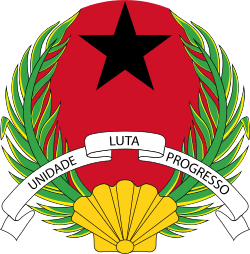

.svg.png)
.svg.png)


